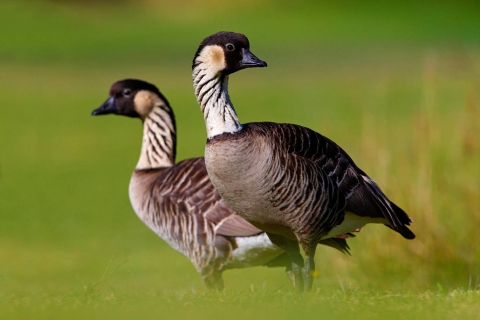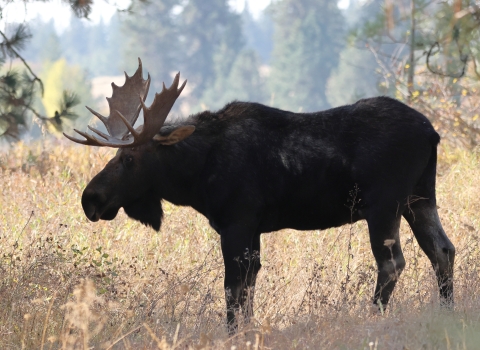The nēnē, sometimes called the Hawaiian goose, is an endemic species found only on the Hawaiian Islands and is the official state bird. Once common, the species declined to only 30 individuals by 1957 due primarily to habitat destruction, introduction of predators, and historic hunting pressure. Thanks to the dedication of the State, its many partners, and agency funding like the U.S. Fish and Wildlife Service’s (Service) Wildlife Restoration Program grants, the nēnē population has risen to over 3,500 individuals today.
To the average person outside of Hawai‘i, the nēnē may seem like just another goose, lacking the bright feathers that many tropical bird species are known for. However, the nēnē is the last surviving species of the eight goose species once found on the Hawaiian Islands. Recently discovered fossils suggest that the ancient distribution of nēnē included Kauaʻi, Molokaʻi, Maui, and the Big Island. Prior to the arrival of Capt. James Cook in 1778 there were an estimated 25,000 nēnē across the Hawaiian Islands. By the mid 1900’s, the wild population was estimated at 30 individuals. A major contributor to their decline was the introduction of non-native predators including rats, mongooses, cats, dogs and pigs that can disturb the ground-nesting birds and feed on young nēnē and eggs. “People don’t realize how close these birds were to extinction, with just 30 birds in the 1950s,” said Raymond McGuire, biologist with the Hawai‘i Department of Land and Natural Resources Division of Forestry and Wildlife. “Today we have over 3,500 and are working to keep the nēnē wild.”
The Wildlife Restoration Program is the nation's oldest and most successful wildlife restoration program. For more than 80 years, it has served as a model of conservation partnership among industry, states and territories, and the federal government, protecting and restoring wildlife and the lands they depend on for current and future generations. The nēnē is one of many Hawaiian species that have benefitted from these grants. “Through Wildlife Restoration Program funds the Service has collaborated on a variety of actions to recover the nēnē species,” said Chris Swenson, the Service’s WSFR grant manager for Hawaiʻi. “This includes controlling invasive mammalian predators that prey on nēnē, managing habitat and vegetation, maintaining predator-proof fences to protect nesting birds, and conducting nēnē monitoring and surveys.”
“The needs for protecting species is vast and complex. It takes the shared knowledge and resources of partnering agencies, NGO's, and even individuals to protect and recover Hawaii's unique flora and fauna,” added McGuire. There is still a long road to full recovery for the nēnē, but the species was downlisted from endangered to threatened in 2019. “Wildlife Restoration (Program) funds support great on-the-ground work with our partners,” explains Swenson. “Recovering this iconic species is a team effort with dedicated partners and other stakeholders working together to bring back the nēnē.”
The Service and these stewardship partners will continue a collaborative approach to recover nēnē and the dozens of other bird species endemic to Hawai‘i to foster conservation of the region’s ecosystems and culturally important species.
To learn more about these efforts view the new Hawai‘i Department of Land and Natural Resources Division of Forestry and Wildlife video highlighting nēnē: DLNR DOFAW (vimeo.com)




